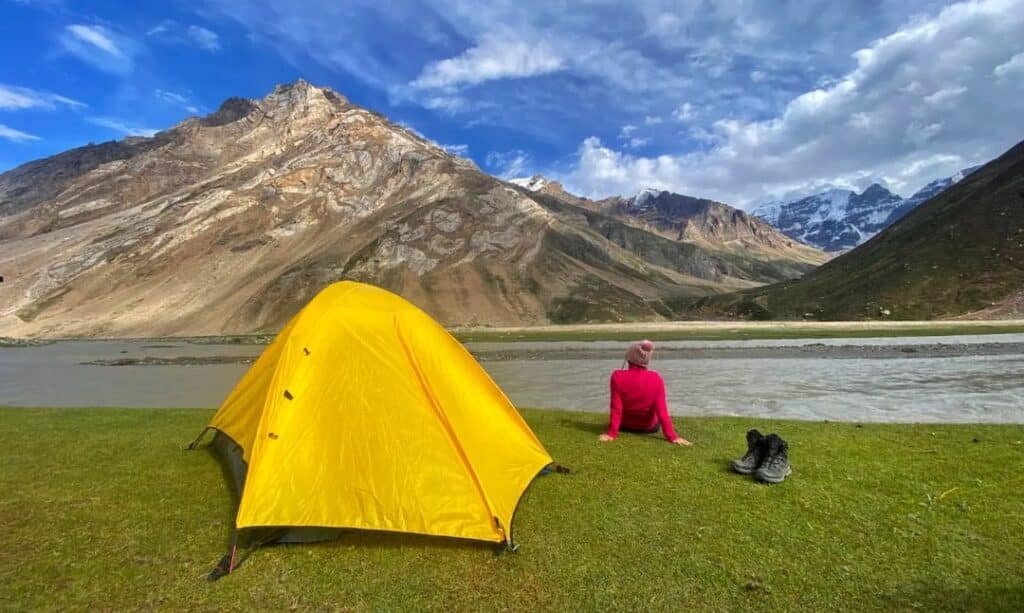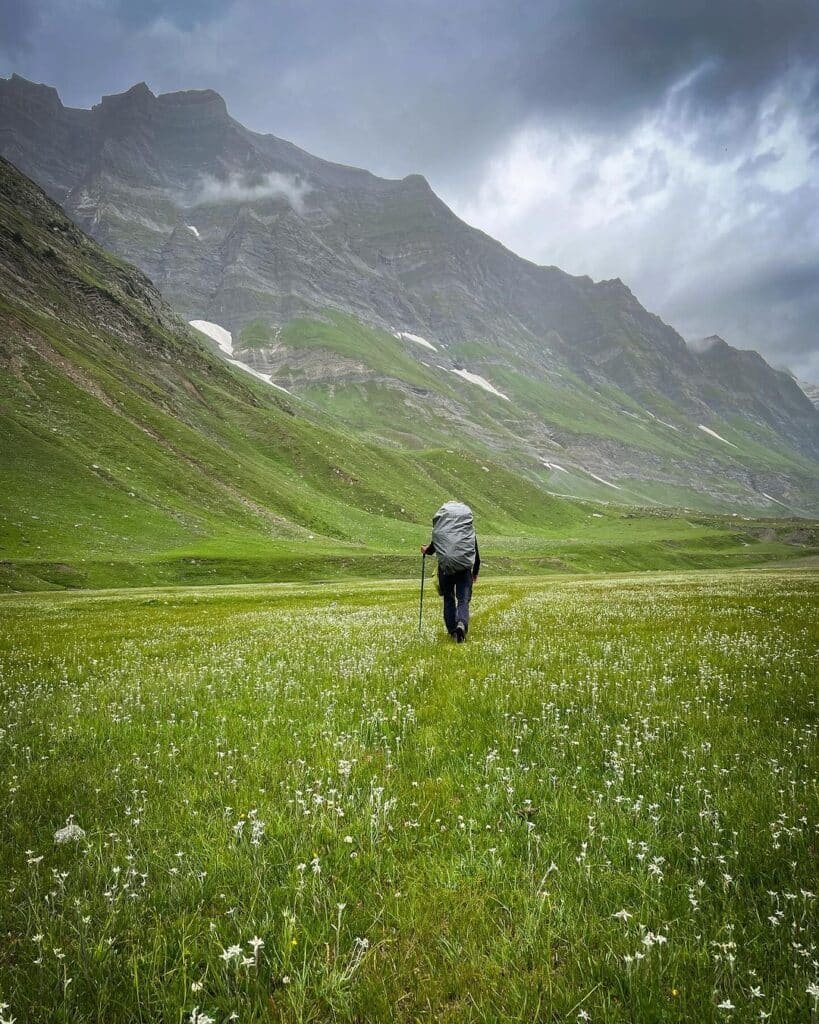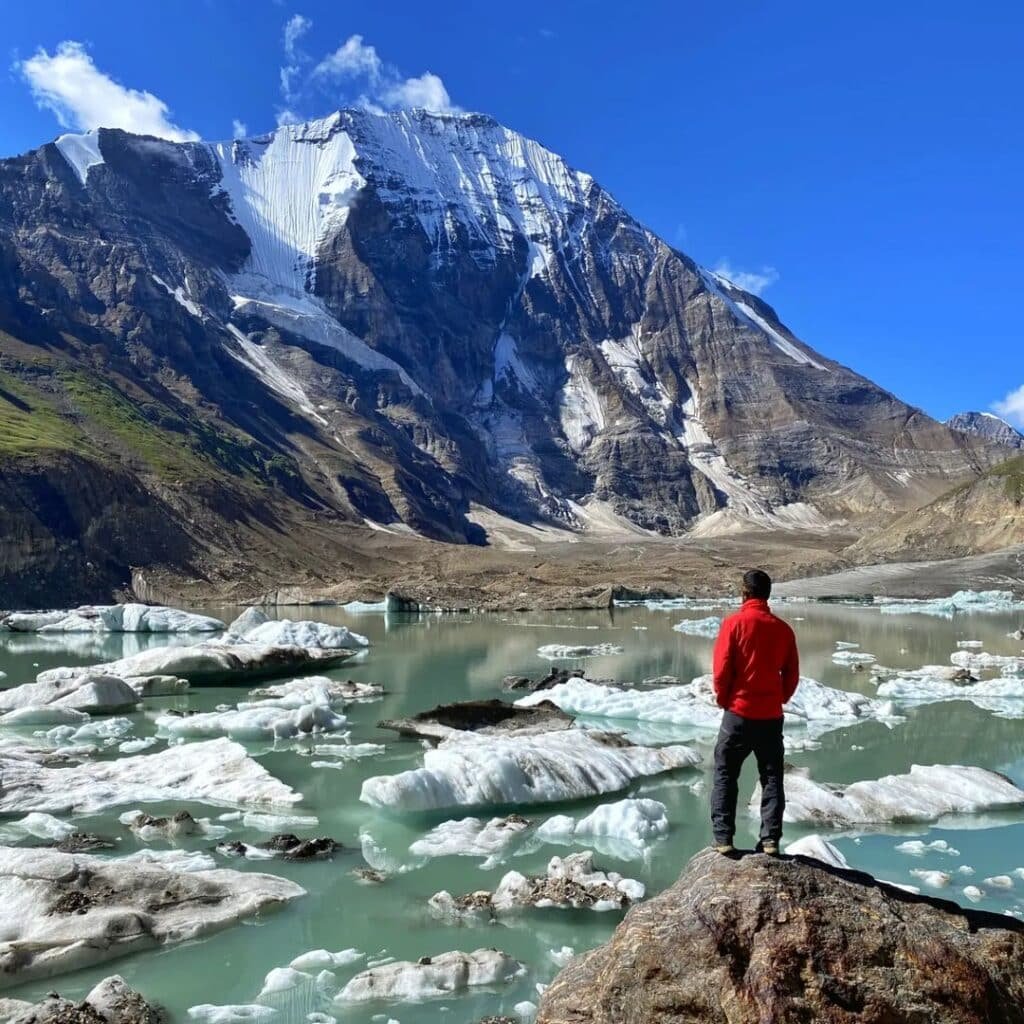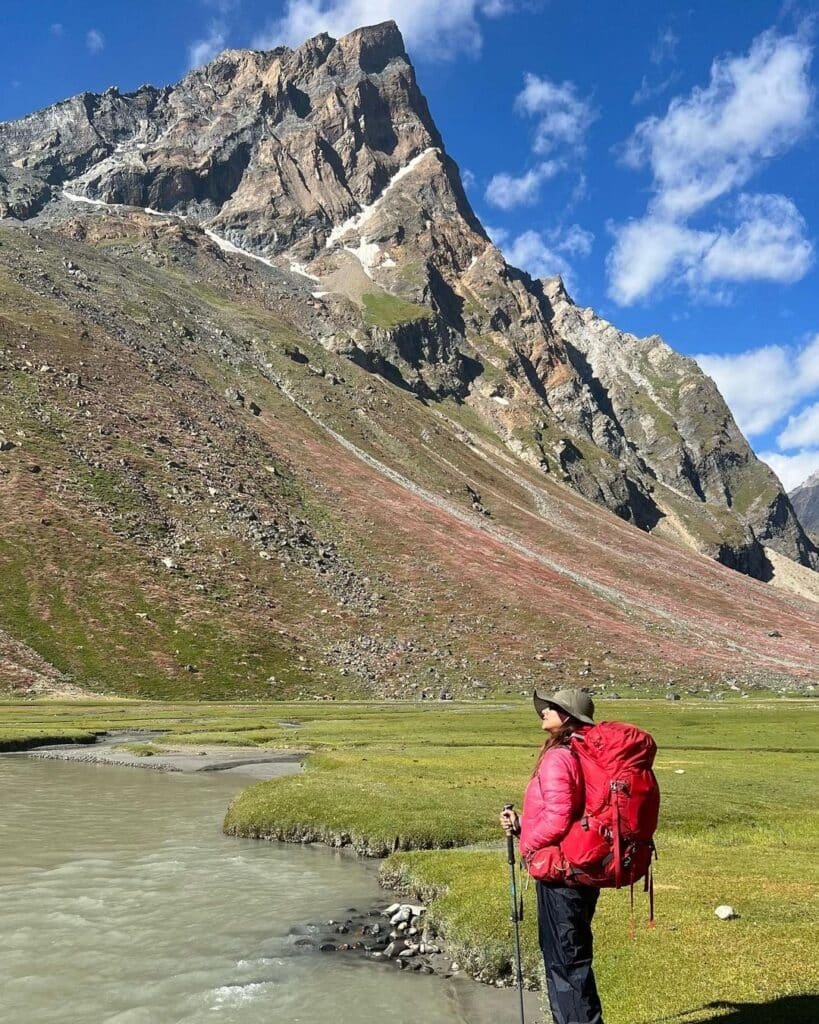Warwan Valley Trek – Complete Guide
- Trekking Destinations
-
Nov 27
- Share post
Nestled amidst the Suru Valley, the Warwan Valley Trek is a testament to nature’s unparalleled beauty and the allure of unexplored landscapes. Embarking on this expedition requires enthusiasm and guidance owing to its challenging terrain and captivating yet demanding trails. A trekking guide becomes indispensable, offering insight and expertise crucial for traversing the breathtaking but rugged Warwan Valley.
This guide unveils the essence of the Warwan Valley Trek, shedding light on its significance, the role of a guide, and the remarkable features that render it an adventure seeker’s paradise. Discover the unparalleled beauty of this Himalayan haven and the enriching experiences that await along the winding paths of this remarkable trek.
- Max Altitude: 14,495 Ft. (4,418M)
- Average Trekking Fees: ₹20,000 - ₹23,000
- Distance: 80 – 95 kms
- Difficulty: Difficult
- Duration: 8-9 days
- Ideal For: Experienced Trekkers Only
- Best Season: July – August
- Region: Jammu & Kashmir
Table of Contents
ToggleUnderstanding the Warwan Valley Trek

The Warwan Valley Trek isn’t just a stroll through picturesque landscapes; it’s a challenge that demands respect for its rugged terrain and altitude variations. Classified as a strenuous trek, it beckons adventurers with its thrilling yet demanding trails. This trek isn’t recommended for beginners due to its steep ascents, descents, and unpredictable weather conditions. Prior trekking experience in high-altitude regions becomes a prerequisite for tackling this expedition successfully.
The right gear and equipment is paramount for a safe and enjoyable journey. Sturdy and comfortable hiking boots are indispensable, offering ankle support on rocky paths. Layering up with insulated clothing is vital, given the fluctuating temperatures. At the same time, a reliable backpack, trekking poles, and a high-quality sleeping bag are essential companions throughout this trek.
Apart from gear, mastering specific trekking skills is crucial. Navigation expertise (including map reading and using a compass or GPS) is fundamental due to the varying trails. Basic first aid knowledge is indispensable for any unforeseen situations that might arise amidst remote terrains.
Preparing adequately by honing these skills and assembling the necessary gear is imperative for anyone venturing into the Warwan Valley. It’s not merely a trek; it’s an expedition that demands readiness, experience, and a profound respect for nature’s unpredictable yet captivating offerings.
Navigating Remote Trails and Trail-less Sections
In the heart of the Warwan Valley lie hidden paths, untrodden and waiting to reveal their raw, untouched beauty. These remote trails offer a chance to disconnect from the beaten track, providing solitude amidst pristine landscapes. However, navigating these less frequented routes demands a keen sense of direction and an astute understanding of the terrain. The absence of marked paths calls for reliance on map-reading skills and orientation techniques, ensuring a safe passage through these uncharted territories.
Trail-less sections within the valley pose a unique challenge, requiring trekkers to forge their own way through dense vegetation or rocky outcrops. Techniques such as using natural landmarks as guides, following animal trails, and employing basic orientation skills become invaluable in traversing these unmarked terrains. Patience and a steady pace are key when manoeuvring through these areas, enhancing the trek’s sense of adventure while immersing oneself in the raw beauty of untouched landscapes.
Overcoming Natural Obstacles: Crevasse Crossings and River Streams
The Warwan Valley’s rugged terrain presents natural obstacles that demand careful navigation. Some sections feature crevasses, requiring trekkers to exercise caution and employ safety measures such as using ropes, harnesses, and proper foothold techniques to cross these treacherous gaps securely.
Additionally, navigating river streams along the route necessitates a calculated approach. Maintaining balance while wading through these streams is crucial. Trekking poles offer stability, ensuring a firm foothold on slippery riverbeds. Evaluating the depth and current flow before crossing and choosing the safest route is imperative for a safe passage across these natural waterways. Embracing the challenge while respecting the power of nature’s elements adds an exhilarating dimension to the Warwan Valley Trek.
Planning Your Warwan Valley Trek

Best Time to Visit Warwan Valley
Choosing the suitable time for your Warwan Valley Trek hinges on understanding the nuances of its seasons. The ideal window to explore this Himalayan wonderland typically spans July to August. The weather is relatively favourable during this period, with milder temperatures and clearer skies facilitating better trail accessibility. The summer offers a picturesque landscape adorned with blooming wildflowers. At the same time, the autumnal months paint the valley with vibrant hues, making it a photographer’s paradise. However, monsoon rains in July and August might pose challenges due to slippery trails and occasional landslides, necessitating extra caution.
Permits and Regulations
Before embarking on the Warwan Valley Trek, you must acquaint yourself with the necessary permits and regulations. Since the valley often traverses remote and protected regions, obtaining permits from local authorities or trekking agencies might be mandatory. These permits ensure a regulated flow of trekkers and aid in maintaining the area’s ecological balance. Additionally, staying informed about specific regulations, such as waste disposal norms or camping restrictions, contributes to preserving the pristine environment and ensures a harmonious trekking experience for adventurers and the local ecosystem.
Prior research and coordination with local authorities or reputable trekking agencies can provide comprehensive guidance regarding permits and regulations, ensuring a smooth and compliant journey through the captivating landscapes of the Warwan Valley.
Budget Breakdown for Warwan Valley Trek
- Trekking Fees: On average, trekking organisations in India charge between ₹20,000 to ₹23,000 for the Warwan Valley Trek. This comprehensive fee usually covers guides, permits, camping facilities, and safety equipment.
- Transportation: Costs for reaching the trek’s starting point vary based on personal preferences. Flights or trains to Srinagar are common choices, followed by a journey to Panikhar. Budgeting for transport should include these expenses.
- Accommodation: Accommodation costs are typically included in the trekking fees as camping arrangements. Hence, no additional charges are incurred for lodging.
- Equipment & Gear: Renting trekking equipment like sleeping bags, tents, and backpacks can be a cost-saving option instead of purchasing new gear. This approach helps reduce upfront costs significantly.
- Food & Water: The trekking fees generally cover meals for the duration. However, carrying extra snacks or personal food preferences is advisable and may involve additional expenses.
- Miscellaneous Expenses: Factor in miscellaneous expenses like personal medication, travel insurance, local transportation, and souvenirs. These smaller costs can collectively impact the overall budget.
While the trekking fees encompass a significant portion of the expenses, considering additional costs like transportation, personal gear, and miscellaneous expenditures is crucial for effective budget planning. Opting for gear rentals and prudent spending on additional items can contribute to managing costs while ensuring a fulfilling and memorable Warwan Valley trekking experience.
Reaching the Starting Point: Journey from Srinagar to Panikhar

From Srinagar to Warwan Valley
Traversing from the bustling city of Srinagar to the serene enclave of Warwan Valley offers travellers multiple transportation options. For those journeying independently, public transportation or private taxis serve as viable modes to reach this Himalayan gem. If embarking on the trek with a trekking organization, transportation arrangements from Srinagar to the base camp at Panikhar village are typically facilitated by the trekking agency, streamlining the journey for trekkers.
Travel Options:
Trekking with a Trekking Organization:
Suppose you’ve opted to trek with a reputable trekking organisation. In that case, the trekking agency generally handles commuting logistics from Srinagar to Panikhar village and back. This includes arranging transportation ensuring a hassle-free transition from the city to the trek’s starting point.
Independent Travellers:
The route involves a two-stage journey for those venturing solo or choosing to travel independently. Commence by taking either a bus or shared cab from Srinagar to Kargil. Another leg of the trip from Kargil involves boarding a shared cab or local bus destined for Panikhar village. This transportation sequence allows for flexibility in travel schedules. It offers a glimpse of the scenic transitions from urban landscapes to the rugged beauty of the Warwan Valley.
Panikhar village is more than just a starting point; it’s a threshold to an adventure-filled expedition. Setting up base camp here not only marks the inception of the trek but also introduces trekkers to the captivating vistas and anticipatory excitement that define the Warwan Valley experience.
Highlights of the Warwan Valley Trek

The Warwan Valley trek is a tapestry of breathtaking highlights woven into the fabric of the Himalayas, offering an expedition like no other.
- Untouched Wilderness: Embrace the pristine beauty of untouched landscapes as you traverse through rolling meadows, dense forests, and rugged terrains, immersing yourself in nature’s untouched canvas.
- Alpine Lakes: Encounter shimmering alpine lakes dotting the landscape, serving as serene camping sites. These mirrored waters reflect the surrounding peaks, creating surreal vistas that captivate the soul.
- Cultural Immersion: Engage with the warm-hearted locals in remote villages nestled amidst the mountains. Experience their traditional way of life, savour local delicacies, and share stories that enrich your journey.
- Varied Terrain: Challenge yourself with diverse terrains – from gentle slopes and meandering trails to steep ascents and rocky paths. Each step unveils a new aspect of the valley’s rugged beauty.
- Panoramic Vistas: Marvel at panoramic views of snow-capped peaks, vast meadows, and winding rivers that paint a picturesque backdrop at every turn, offering a photographer’s paradise.
- Wildlife Encounters: Catch glimpses of Himalayan wildlife, from grazing yaks to playful marmots, adding an element of wilderness to your trekking experience.
- Remote Trails and Solitude: Explore lesser-known paths offering solitude and natural beauty. Navigate these uncharted territories, relying on your instincts and the allure of undiscovered trails.
- Crevasses and Streams: Conquer natural obstacles like crevasses and river streams with caution and skill, adding an element of adventure while crossing these challenging terrains.
- Camping Under the Stars: Experience the magic of camping under star-studded skies, surrounded by the tranquil serenity of the Warwan Valley, fostering a deep connection with nature.
- Culmination at Mati Gawran: Culminate your journey at Mati Gawran, soaking in the final moments of this unforgettable trek, reflecting on the challenges conquered and the beauty embraced along the way.
Warwan Valley Trek Day-wise Itinerary

1: Drive from Srinagar to Panikhar
- Distance: 185 km
- Duration: 10 hours
- Activity: The journey from Srinagar to Panikhar is a picturesque drive through changing landscapes, quaint villages and scenic vistas. Arriving at Panikhar, trekkers are greeted by the stunning backdrop of the surrounding peaks, setting the stage for the adventure ahead.
2: Trek from Panikhar to Denora
- Trek Distance: 14 km
- Duration: 8 hours
- Trail Description: The trek commences from Panikhar, leading through rolling hills and meadows. The trail gradually gains altitude, offering glimpses of the valley’s beauty. Denora serves as the campsite, nestled amidst the serene expanse, providing a peaceful night’s rest.
3: Trek from Denora to Kalapari
- Trek Distance: 2 km
- Duration: 2.5-3 hours
- Trail Description: Although a shorter trekking day, this segment provides a relaxed pace, allowing trekkers to absorb the surroundings. Kalapari, with its tranquil ambience, offers a perfect setting for unwinding and preparing for the upcoming longer treks.
4: Trek from Kalapari to Kaintal
- Trek Distance: 17 km
- Duration: 13-14 hours
- Trail Description: This day entails a longer trek through varying terrain, encompassing challenging stretches and rewarding landscapes. As trekkers traverse from Kalapari to Kaintal, they navigate through rugged trails and panoramic vistas, reaching the campsite after a demanding yet fulfilling journey.
5: Trek from Kaintal to Humpet
- Trek Distance: 17 km
- Duration: 7-8 hours
- Trail Description: The trek from Kaintal to Humpet involves a moderate hike, passing through verdant meadows and offering glimpses of the valley’s diverse flora and fauna. Trekkers settle at Humpet, basking in the tranquillity of the surroundings.
6: Trek from Humpet to Sukhnai
- Trek Distance: 15 km
- Duration: 7-8 hours
- Trail Description: Continuing the expedition, the trek to Sukhnai unfolds through captivating landscapes and gentle slopes. Trekkers immerse themselves in the valley’s beauty, camping at Sukhnai, a serene spot amidst nature’s embrace.
7: Trek from Sukhnai to Basmina and Drive to Mati Gawran
- Trek Distance: 14.5 km
- Trek Duration: 6-7 hours
- Trail Description: The trek’s final leg leads from Sukhnai to Basmina. From there, a drive to Mati Gawran culminates the trek, offering a seamless transition from the trekking expedition back to civilization.
8: Buffer Day
- Activity: The buffer day is a contingency for any unforeseen circumstances, providing flexibility in the itinerary.
9: Travel from Mati Gawran to Srinagar
- Drive Distance: 111 km
- Duration: 3-4 hours
- Activity: The journey back to Srinagar marks the trek’s conclusion, allowing time to reflect on the memorable experiences amidst the majestic landscapes of the Warwan Valley.
Conclusion
Embarking on the Warwan Valley Trek isn’t just a journey; it’s an odyssey through nature’s grandeur, an invitation to unravel the secrets of the Himalayas.
This challenging expedition rewards adventurers with unparalleled beauty, weaving stories of alpine lakes reflecting mountain peaks, encounters with local cultures, and moments of solitude amidst untouched wilderness. The trek demands resilience, offering a diverse terrain that tests your limits while unveiling the valley’s breathtaking panoramas.
However, amidst this allure, a call for responsibility echoes. As we tread upon these pristine landscapes, preserving their integrity becomes imperative. Responsible tourism stands as our pledge to safeguard the natural sanctity of the Warwan Valley. Every step should aim to leave minimal impact, ensuring this paradise remains unspoiled for generations.
So, heed the call of the mountains, embrace the challenge, and immerse yourself in the beauty of the Warwan Valley. Let this trek be an adventure and a promise to cherish and protect the essence of nature’s splendour, for its magic endures in our responsible footsteps.
FAQs
The Warwan Valley sits at an elevation ranging from approximately 7,000 feet to 14,000 feet above sea level.
The population of the Warwan Valley is relatively sparse, with estimates suggesting a few thousand residents spread across its villages.
Kashmir is termed a valley due to its geographical layout. It is surrounded by the Himalayas and Pir Panjal mountain ranges, creating a vast depression or lowland area.
In the Kishtwar district, several valleys contribute to its scenic beauty, including the Warwan Valley, Marwah Valley, and Padder Valley, each boasting distinct landscapes and cultural significance.
Kuari Pass | Bhrigu Lake | Brahmatal Trek | Sar Pass Trek | Shrikhand Mahadev Trek | Buran Ghati Trek | Bali Pass Trek | Kareri Lake Trek | Rupin Pass | Kashmir Great Lakes Trek | Kareri Lake Trek | Rupin Pass | Hampta Pass Trek | Goechala Trek | Har ki Dun Trek | Sandakphu Trek | Dayara Bugyal Trek | Kedarkantha Trek | Chadar Trek | Tarsar Marsar Trek
Did you like this trek guide for the Warwan Valley Trek?
We have 100s more such guides on similar off-beat experiences & we send out such guides, offers, hidden gems, and trekking destinations weekly via email. Subscribe to our newsletter to get them directly into your inbox.
